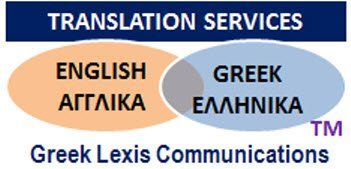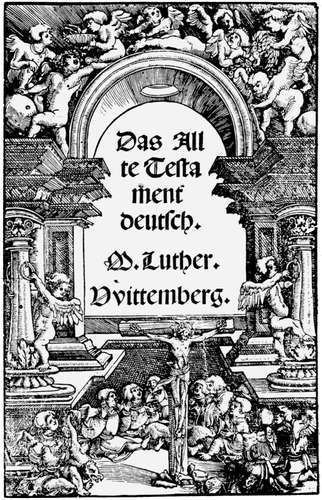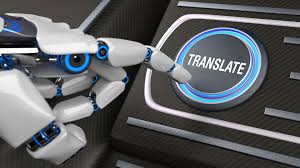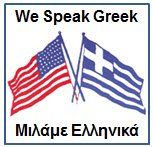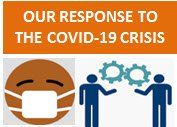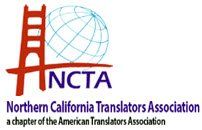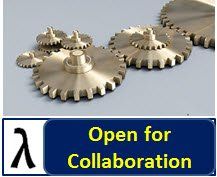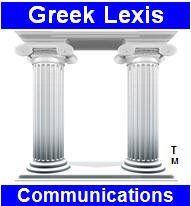Our English < > Greek Translation Services Include:
EDUCATION: Textbooks, workbooks, study guides, lecture notes, and other instructional materials.
FINANCIAL: Annual reports; tax records; financial statements; business plans.
HUMAN RESOURCES MANAGEMENT: Policies and procedures; online benefits; employment records; employee training documents and online learning systems.
INSURANCE: Commercial and personal policies; liability claims and reports.
LEGAL: Contractual agreements; real estate transactions; interpreting of court testimonies and workers’ compensation hearings.
LOCALIZATION: Website content; search engine optimization; e-books; software; video and online games.
MARKETING: Marketing collateral; advertising brochures; product specifications; user manuals; plans; newsletters; event announcements.
MASS MEDIA: Voice-over and dubbing for radio, television, movies, web casts, and pod casts; movie subtitling; interpreting of conferences and presentations.
MEDICAL: Regulatory compliance reports; health care product descriptions and labels; medical research; surgical instrument user guides; equipment manuals.
PERSONAL: Divorce decrees; wills; trusts; real estate property transactions; correspondence; employment documents; birth certificates; marriage certificates; declarations; applications.
PUBLISHING: Fiction; literary works; news reports; magazine articles.
TECHNICAL: Scientific; information technology; software applications; user interface design; e-books.
Translation Methods
Webster’s Dictionary defines “translation” as “the written rendering from one language into another; also, the product of such a rendering.” Various methods have been developed as a means of ensuring the accuracy and fidelity of the translated text, in content as well as in context. Translation methods include the following:
[ 1 ]
Formal Equivalence:
The translated text is a direct or literal translation, composed of the exact words, the exact order, and the exact syntax of the source language. An example of this method is a Greek-English interlinear Bible. The primary concern with this method is that the text in English is difficult to read and often impossible to comprehend.
[ 2 ] Paraphrasing:
The translated text is a restatement, “in other words”, of the source text. The focus and benefit of this approach is the preservation of the source idea, not the source meaning, in the target language.
[ 3 ] Functional Equivalence:
The focus of this method is to achieve readability and comprehension by preserving the source meaning in the target language. The translated text does not always match with the grammatical and syntactical aspects of the source language but this is not necessarily a drawback.
[ 4 ] Calque:
This is the process of borrowing a word or phrase from the source language while translating its components so as to create a new lexeme in the target language. In the information age, calque (from French, to copy, to trace) is a useful method of reproducing and replicating technical terms.
[ 5 ] Transposition:
The translated text is the result of indirect translation. This approach is typically used in translating literary and poetry works because it seeks to preserve meaning by replacing the same grammatical class in the target language.
William Tyndale
Pioneer Translator of New Testament from Greek to English, 1535.
Hulton Archive/Stringer/Getty Images
Tyndale's chief ambition in life was to give common English speakers a translation based on the original Greek and Hebrew languages of Scripture.
(Adapted from https://www.learnreligions.com)
MT platforms are used to translate vast amounts of information involving millions of words that could not possibly be translated the traditional way. The quality of MT output can vary considerably. Depending on the complexity of the project, MT can augment productivity, contain costs, and provide post-editing services.
Generic MT Systems
include Google Translate, Bing Translate, Yandex, and Naver. These systems are trained by vast amount of online content, typically short sentences and controlled terminology, and they can be helpful in providing an approximate translation.
Customizable MT
refers to translation software that can be trained to improve terminology accuracy in a chosen domain, such as medical, legal, or a company’s own internal terminology. Customizable MT can be set up to run on statistical models, a rules-based approach, or a hybrid integration.
Adaptive MT
learns from input in real time and offers suggestions to translators.
Neural MT (NMT)
is one of the latest efforts towards building a single, large neural network that reads full and rather complex sentence and outputs a correct translation.
(Sources: American Translator Association. Globalization and Localization Association)
MACHINE TRANSLATION FOR GREEK
In highly inflected languages, such as Greek, the use of MT can offer only a generic text that must be reviewed and post-edited diligently by a native-speaker translator. Greek < > English machine translations typically result the following semantic and morphological errors:
1] Ambiguity
2] Lexical mismatches
3] Syntactical mismatches
4] Grammatical aspects
